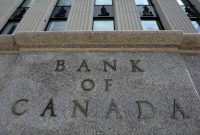Support strong Canadian climate journalism for 2025
The loonie hit 80 cents US on Monday, a level it hasn't closed at in more than two years, against a weakening in U.S. currency and amid further signs of a strengthening Canadian economy.
The Canadian dollar, which ended up with an average trading price of 79.92 cents US, up 0.23 of a cent, has been steadily climbing over the last two months.
Since early May, it has added more than seven cents. Its upward march has been fuelled by the Bank of Canada's decision earlier this month to raise its key benchmark interest rate for the first time in close to seven years.
There are now expectations that one or possibly two more rate hikes could be in the offing before the end of the year as signs continue to point to a robust economy.
Earlier Monday, Statistics Canada reported that wholesale sales hit a record high in May as they climbed 0.9 per cent to $61.6 billion. Economists had expected an increase of 0.5 per cent, according to Thomson Reuters.
Isaac Holloway, an assistant professor at the Ivey Business School at Western University, said the gain in the Canadian dollar will have the biggest effect on importers and exporters, though it will likely be months before consumers see the fallout.
"Anyone importing or consuming imported goods could be seeing relief on the price front," he said from London, Ont.
"On the flip side, anybody who is exporting is going to have to lower their prices to remain competitive with foreign competitors."
A stronger loonie will also likely encourage more Canadians to travel south of the border, he added.
Shaun Osborne, chief currency strategist at Scotiabank, said he doesn't expect the dollar to rise much more despite the strong economic performance as of late.
"A lot of good news is already priced in at this point," he said.
"It's difficult concocting what else will help it continue to rise. We'll see a stabilization in the short run for the Canadian dollar."
Osborne noted that there are a number of factors besides monetary policy that has helped the currency rise. The loonie has benefited from a lower U.S. dollar, which has been hit in recent months by political uncertainty under the Donald Trump administration.
But the greenback can strengthen, and in turn, bring the Canadian dollar lower, if the U.S. Federal Reserve continues on its interest rate hike schedule this year. The Fed kicks off its latest two-day monetary policy meeting on Tuesday.
Oil prices, which also heavily influence the loonie, have been stuck between US$40 and US$50 per barrel in recent weeks. Expectations are that crude prices won't break out from that range, which would mean the Canadian dollar will not find additional support from the commodity.
"It's going to be difficult for the Canadian dollar to advance at its current pace without more significant news and it's difficult to see where that news is going to come from," said Osborne.
On Bay Street, Canada's main stock index pulled back moderately as gold and materials stocks lost ground. The Toronto Stock Exchange's S&P/TSX composite index was down 54.44 points to 15,128.69.
In New York, the Dow Jones industrial average declined 66.90 points to 21,513.17 and the S&P 500 index lost 2.63 points to 2,469.91. The Nasdaq composite index was up 23.06 points to 6,410.81, a record high.
In commodities, the September crude contract added 57 cents to US$46.34 per barrel and September natural gas fell eight cents to US$2.88 per mmBTU.
August gold lost 60 cents at US$1,254.30 an ounce and September copper was up one cent to US$2.74 a pound.





Comments